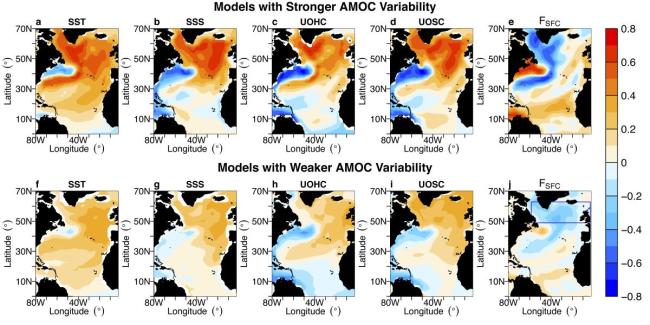Underestimated AMOC variability in climate models has broad implications
Estimating the amplitude of low-frequency Atlantic meridional overturning circulation (AMOC) variability in observations is very important given its potentially profound climate impacts. Currently, the longest available direct observation of AMOC is from the RAPID program since 2004. Hence a direct estimate of the amplitude of low-frequency AMOC variability is not yet available. In addition, the Atlantic multidecadal variability (AMV), a large-scale mode of multidecadal variability in the Atlantic Ocean, also has many important regional and global-scale climate impacts. Previous studies showed that the simulated correlations between the AMOC and the AMV sea surface temperature signal in fully coupled models are not robust and vary substantially across models, challenging our understanding of the role of AMOC in AMV and its associated climate impacts in the real world. A natural question is whether the diverse linkages between the AMOC and the AMV sea surface temperature signal in different models are related to the simulated amplitudes of low-frequency AMOC variability.

In a recent paper published in Geophysical Research Letters, Yan et al. inferred the amplitude of low-frequency AMOC variability indirectly using both the RAPID AMOC observations and the much longer record of an observed extratropical AMOC fingerprint derived from a subsurface ocean temperature dataset. Using both observations and simulations from multiple models of the Coupled Model Intercomparison Project (CMIP), they showed that most models underestimate the amplitude of low-frequency AMOC variability. In addition, stronger low-frequency AMOC variability leads to stronger linkages between the AMOC and key variables associated with AMV, and between the subpolar AMV signal and Northern Hemisphere surface air temperature. Low-frequency extratropical Northern Hemisphere surface air temperature variability might increase with the amplitude of low-frequency AMOC variability. Atlantic decadal predictability is much higher in models with stronger low-frequency AMOC variability and much lower in models with weaker or without AMOC variability.
This study provides a new perspective for understanding the important role of the AMOC in AMV and associated impacts and predictability. The results indicate that the linkages between the AMOC and AMV, as well as associated climate impacts and Atlantic decadal predictability, could be substantially hampered in models due to their underestimation of the amplitude of low-frequency AMOC variability. Identifying the limitations of models in simulating the low-frequency AMOC variability is helpful to understand and resolve the diverse linkages between the AMOC and AMV in multiple models.
Underestimated AMOC Variability and Implications for AMV and Predictability in CMIP Models (Geophysical Research Letters)
1Princeton University
2NOAA Geophysical Fluids Dynamic Laboratory
Topics
- Modeling
- Atlantic Ocean
- AMOC
